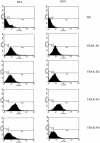The role of osteoprotegerin and tumor necrosis factor-related apoptosis-inducing ligand in human microvascular endothelial cell survival
- PMID: 15064358
- PMCID: PMC420106
- DOI: 10.1091/mbc.e04-01-0059
The role of osteoprotegerin and tumor necrosis factor-related apoptosis-inducing ligand in human microvascular endothelial cell survival
Abstract
Endothelial cell survival and antiapoptotic pathways, including those stimulated by extracellular matrix, are critical regulators of vasculogenesis, angiogenesis, endothelial repair, and shear-stress-induced endothelial activation. One of these pathways is mediated by alpha(v)beta(3) integrin ligation, downstream activation of nuclear factor-kappaB, and subsequent up-regulation of osteoprotegerin (OPG). In this study, the mechanism by which OPG protects endothelial cells from death was examined. Serum-starved human microvascular endothelial cells (HMECs) plated on the alpha(v)beta(3) ligand osteopontin were protected from cell death. Immunoprecipitation experiments indicated that OPG formed a complex with tumor necrosis factor-related apoptosis-inducing ligand (TRAIL) in HMECs under these conditions. Furthermore, inhibitors of TRAIL, including recombinant soluble TRAIL receptors and a neutralizing antibody against TRAIL, blocked apoptosis of serum-starved HMECs plated on the nonintegrin attachment factor poly-d-lysine. Whereas TRAIL was unable to induce apoptosis in HMECs plated on osteopontin, the addition of recombinant TRAIL did increase the percentage of apoptotic HMECs plated on poly-d-lysine. This evidence indicates that OPG blocks endothelial cell apoptosis through binding TRAIL and preventing its interaction with death-inducing TRAIL-receptors
Figures







References
-
- Alon, T., Hemo, I., Itin, A., Pe'er, J., Stone, J., and Keshet, E. (1995). Vascular endothelial growth factor acts as a survival factor for newly formed retinal vessels and has implications for retinopathy of prematurity. Nat. Med. 1, 1024-1028. - PubMed
-
- Brooks, P.C., Clark, R.A., and Cheresh, D.A. (1994a). Requirement of vascular integrin avb3 for angiogenesis. Science 264, 569-571. - PubMed
-
- Brooks, P.C., Montgomery, A.M.P., Rosenfeld, M., Reisfeld, R.A., Hu, T., Klier, G., and Cheresh, D.A. (1994b). Integrin avb3 antagonists promote tumor regression by inducing apoptosis of angiogenic blood vessels. Cell 79, 1157-1164. - PubMed
MeSH terms
Substances
LinkOut - more resources
Full Text Sources
Research Materials
Miscellaneous

